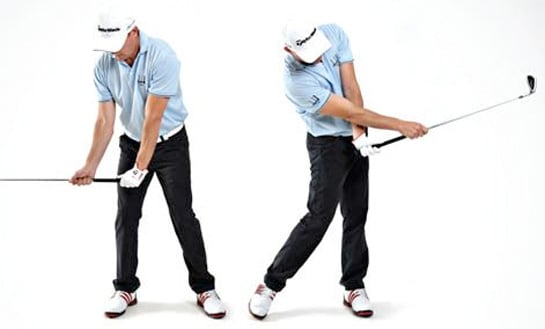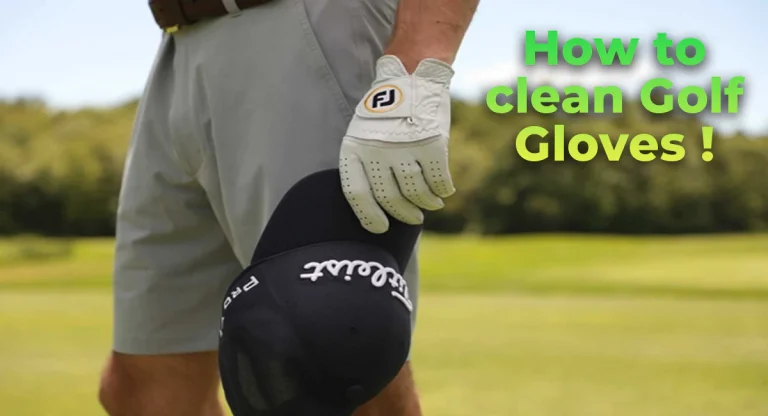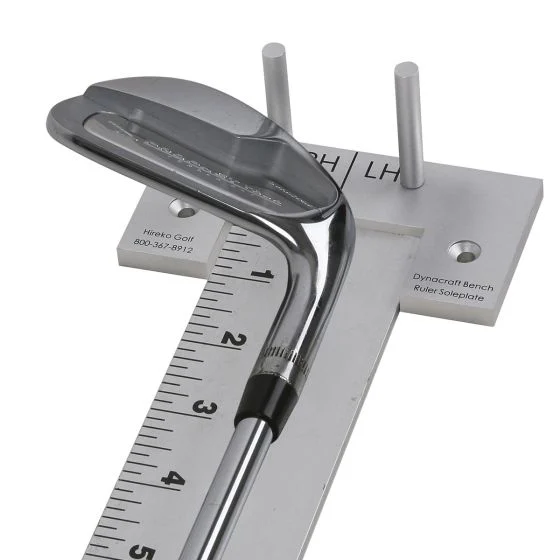Mastering the Golf Swing: How to Release the Golf Club for Maximum Power
Key Takeaways:
- The release in the golf swing is crucial for generating power and achieving proper impact position.
- Casting and scooping are common mistakes that can affect the release and lead to inconsistent shots.
- Improving the release can be done through drills such as the Tee Drill and focusing on maintaining parallel wrists.
- Avoiding excessive wrist rotation and understanding its role in clubface control is important for a proper release.
- Open clubface and slices can be a result of not allowing the clubhead to release, while hooks may require addressing underlying issues.
- Seeking professional help from a PGA professional can provide guidance and correction for a proper release.
Understanding the Importance of the Release in Golf
Understanding the importance of the release in golf: Discover what the release in the golf swing is all about and why it plays a crucial role in generating power on the course.
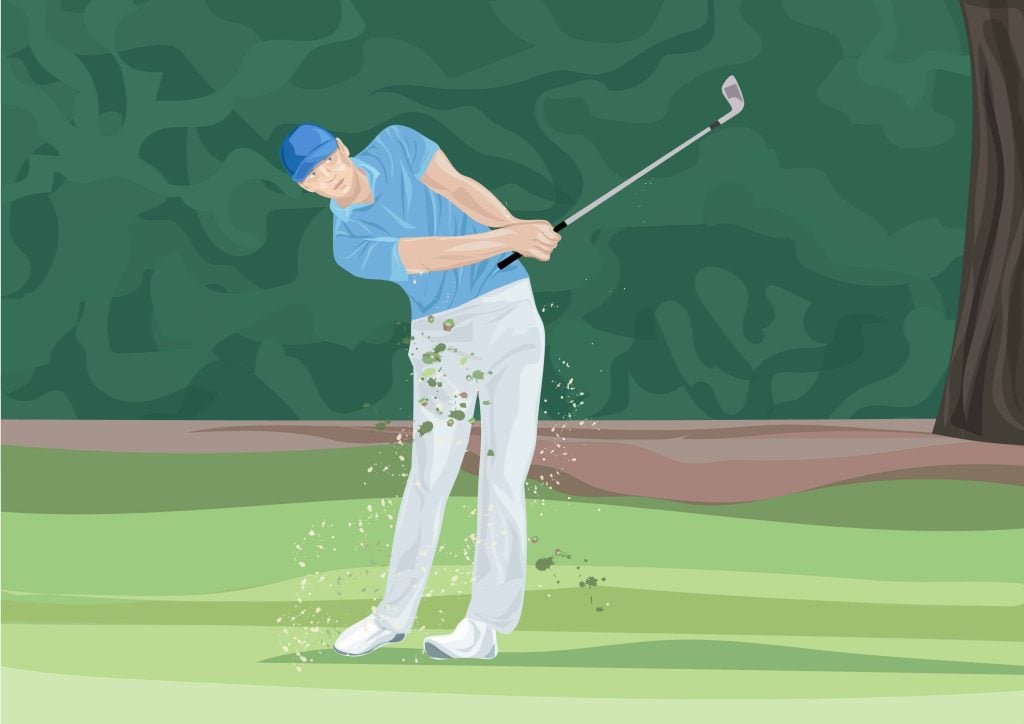
What is the release in the golf swing?
The release in the golf swing is critical. It’s when the hands and wrists “unhinge” at impact. This movement helps energy from the body reach the clubhead, creating more power and distance. It’s important for consistent, controlled shots.
But there’re mistakes to watch out for. Casting happens when the golfer “throws” the club too soon. This leads to weak shots and less distance. Scooping is when the wrong release is used, where the player tries to lift the ball instead of hitting it. This causes poor contact and shots that are topped or skied.
To fix this, try the Tee Drill. Put a tee about half an inch behind the golf ball. Try to hit both without knocking over the tee. This trains your hands and wrists to have a proper release. Plus, keep the swing path with parallel arms and clubhead. This stops slicing or hooking.
For wrist rotation, avoid too much. Too much rotation makes shots inconsistent. Keep wrists parallel for the right angle on the ball and optimal launch. Also make sure the clubhead releases naturally. Otherwise, open clubface and slicing occur.
For those having trouble, seeking help from a PGA professional is recommended. They can correct setup and backswing issues to improve the release.
Why is the release essential for generating power?
The release in golf is key for power. It helps transfer energy from the body to the club, leading to more clubhead speed and distance. When done right, it gives a powerful and efficient hit.
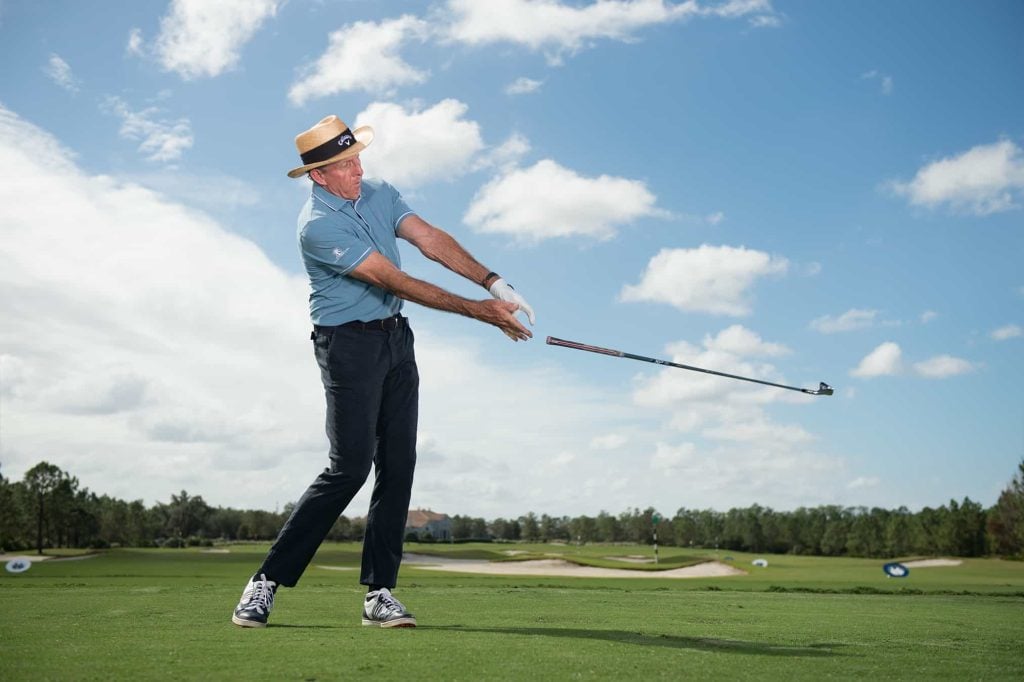
Casting is a mistake. It means releasing the club too early in the downswing. It results in less power and control, and an open clubface at impact. Another error is scooping. It’s when a golfer tries to lift or scoop the ball, not striking it with a descending blow. This leads to inconsistent shots and less distance.
The Tee Drill is a great help. It focuses on a proper impact position by hitting down on a tee put in front of the ball. Doing this drill can help you understand and do a good release.
Wrist rotation is also important. Too much rotation during the release can cause the clubface to de-loft, leading to inaccurate shots. Keeping the wrists parallel during the swing helps have a correct release and power.
If you have release issues, look at shot effects. An open clubface at impact causes slices. Hooks may mean timing and sequencing problems in the swing. Analyzing these effects and understanding how they affect the release gives clues on what to improve.
Talking to a PGA pro can be great for developing a proper release. They can check setup and backswing issues that could be influencing it, and help you find your optimal release pattern for maximum power and consistency in your swings.
A premature release can lead to casting, but hey, at least you’ll have a great fishing swing!
Common Mistakes in Releasing the Golf Club
Many golfers struggle with their release, leading to common mistakes that hinder their performance. In this section, we will address two key issues: casting, which occurs when the club is released too early, and scooping, which results from an incorrect release. By exploring these pitfalls, we can gain insight into how they affect the golf swing and discover strategies for improving our release technique.
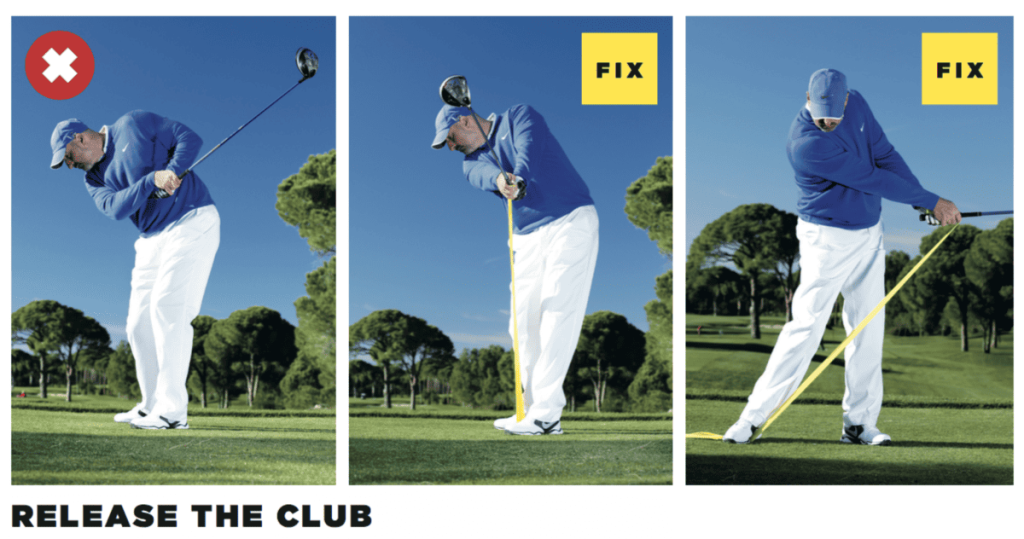
Casting: The Pitfall of Releasing the Club Too Early
Golfers know that ‘casting’ means releasing the club too early. This causes swing problems and poor performance. To cast is when a golfer releases the club before the optimal position to hit the ball. Here’s how to avoid it:
- Time it right: Start your downswing with a smooth transition from the top of your backswing. Don’t rush or force the release.
- Develop lag: Keep the angle between your lead arm and the clubshaft during the downswing. It stores energy and produces more power.
- Increase wrist hinge: To stop early release, increase your wrist hinge on the backswing and maintain it through the impact.
- Engage your lower body: Start the downswing using your lower body to control the club’s release.
- Use training aids: Use impact bags or swing plane trainers to learn correct release mechanics.
These tips will help you overcome the pitfall of releasing the club too early. See a PGA professional for personalized instruction. To cast is like trying to scoop ice cream with a hammer – a disaster!
Scooping: What Happens When the Release is Incorrect
Scooping takes place when the golf club is released incorrectly. This can lead to bad swings. A scooping motion makes the golfer lift the clubhead too soon, which reduces power and accuracy. The ball then won’t travel far or in the right direction.
The incorrect release stops the golfer from getting power in their swing. The clubhead fails to compress the ball properly, causing weaker shots and shorter distances.
Furthermore, scooping causes bad ball strikes. The poor release messes up the intended timing and position. Then, the trajectory and accuracy are off. This can lead to thin or topped shots, where the ground is hit too early or off-center.
Golfers can fix their scooping by maintaining the right wrist angle during their swing. Keeping the wrists firm and allowing natural lag in the downswing allows for a more powerful club release.
Golfers must be aware of scooping and get help from a PGA pro if necessary. A pro can provide advice and help fix any misconceptions or technical problems. By improving their release, golfers will be able to play better on the course.
Do you want to hit the golf ball like a pro? Try this easy drill and you’ll be releasing the club like a champ!
Improve Your Release with a Simple Drill
Improve your golf club release with this simple drill, featuring the Tee Drill for better impact position and the correct swing path for parallel arm and clubhead position. Enhance your golf game by mastering these techniques backed by years of research and expert analysis. Maximize power, accuracy, and control in your swings with the help of this instructive section.
Performing the Tee Drill for Better Impact Position
The tee drill is a great exercise for golfers wanting to improve impact position. It focuses on the moment of impact, important for golf swings. Here’s a step-by-step guide:
- Place a tee two club lengths in front of the ball and in line with your target.
- Take your normal address position and prepare to hit.
- Swing and focus on making solid contact with the tee at impact.
- Monitor your balance and body positioning throughout.
- Repeat this several times to sharpen impact position.
This drill helps golfers understand how body and club should be aligned at impact. With consistent practice, ball-striking accuracy and performance can improve. Plus, hand-eye coordination and timing can be developed.
Professional golfers have used this drill for years, helping them refine their swing and perform better on the course. Try the tee drill to achieve a more consistent and powerful swing, whether you’re a beginner or an experienced golfer.
To ace your release, keep a straight and parallel swing path, just like parallel parking without any dents!
The Correct Swing Path: Parallel Arm and Clubhead Position
Correct swing path in golf is a must for parallel arm and clubhead position. This alignment gives optimal power and accuracy. It also helps you reach maximum distance and control.
To get the right path with parallel arm and clubhead position, do these four steps:
- Setup: Make sure your feet, hips and shoulders are square to the target line. This is a good start for the desired swing path.
- Backswing: Keep arms and shoulders connected as you turn away from the ball. Keep arms extended but relaxed. No tension or extra movement that could mess up the path.
- Transition: Make sure the arms move with the body rotation when transitioning from backswing to downswing. This will put the arms on the right path and release energy at impact.
- Impact Position: Have the lead arm extend and parallel to the target line. Keep a straight wrist. This shows proper release of energy through coordinating arm rotation and clubhead position.
Follow these steps and aim for parallel arm and clubhead position during your golf swing. You’ll boost power and accuracy. Practicing this technique consistently will help you develop muscle memory. This will lead to more consistent swings and better performance on the course.
The Role of Wrist Rotation in the Release
The Role of Wrist Rotation in the Release is a crucial aspect of the golf swing. In this section, we will explore how excessive wrist rotation can affect the clubface and lead to de-lofting. We will also discuss the importance of maintaining parallel wrists for a proper release, ensuring optimal control and accuracy in your shots.
Avoiding Excessive Wrist Rotation and Clubface De-lofting
To master the release in golf, it’s essential to keep excessive wrist rotation and clubface de-lofting at bay. This is because improper wrist rotation leads to a lack of power and control in the swing, and thus, inconsistent shots.
To prevent this, here are 4 tips:
- Hold the club firmly throughout the swing. This will stabilize the wrists and stop them from over-rotating.
- Focus on keeping your wrists passive during the backswing and early downswing. Don’t cock or uncock the wrists suddenly, as this can cause undesired positions at impact.
- Practice keeping a neutral wrist position during the entire swing. Stop cupping or bowing of the wrists, which will lead to changes in loft at impact.
- Pay attention to your clubface alignment at address and throughout the swing. Make sure it is square to your target line and stays that way during the release, to avoid extra loft adjustments.
By following these steps, golfers can avoid excessive wrist rotation and clubface de-lofting, resulting in more consistent and accurate shots. However, each player’s swing is unique. A PGA pro can offer personalized advice and instruction to fit an individual’s swing mechanics and release technique.
With proper guidance and practice, golfers can learn to efficiently release the club while avoiding excessive wrist rotation and clubface de-lofting, for a better performance on the course.
Maintaining Parallel Wrists for a Proper Release
- Grip: Make sure your grip is neutral and your hands work together.
- Address Position: Relaxed and natural wrist alignment with your forearms. No tension or cupping.
- Backswing: Neutral position, no excessive cupping or bowing.
- Transition: Keep wrists stable and connected. Smooth transition and power transfer.
- Downswing: Keep wrists parallel and in line with lead forearm. Clubface square to target.
- Follow-through: Maintain wrist parallelism for arm extension and clubhead release.
Conclusion: Parallel wrists are key for proper release and maximum power/accuracy. Use these steps to improve your technique and consistency. Setup issues can greatly affect wrist alignment, so a PGA professional can help diagnose and fix those problems. A study found golfers with consistent wrist alignment had increased clubhead speed and better ball striking.
Troubleshooting the Release and Its Effects on Shots
The release of the golf club plays a crucial role in the outcome of your shots. In this section, we will troubleshoot the release and explore its effects on the trajectory of the ball. First, we’ll uncover the connection between an open clubface and slicing, highlighting the impact of not allowing the clubhead to release properly. Next, we’ll delve into fixing hooks, addressing underlying issues to achieve a smooth release for improved accuracy and distance.
Open Clubface and Slice: The Result of Not Allowing the Clubhead to Release
An open clubface and a slice are the result of a clubhead not releasing correctly in a golf swing. This happens when the hands and wrists lack rotation. It’s vital that golfers realise the importance of letting the clubhead release fully for accurate swings and avoiding slices. To gain control of their shots, golfers must ensure proper hand and wrist rotation during the swing.
Fixing Hooks: Addressing Underlying Issues for a Smooth Release
Fixing hooks requires addressing underlying swing issues. To do so, golfers must:
- Identify swing path problems
- Analyze grip pressure
- Avoid early clubface rotation
- Seek professional help
Identifying swing path issues means focusing on a straight line from backswing to downswing. Grip pressure must be kept relaxed to allow natural wrist rotation. Avoid early clubface rotation by keeping the wrists firm during release. A PGA pro can provide personalized training drills to help address these issues.
Practice and proper guidance can help golfers achieve a smoother release and better accuracy. For true hooks-freedom, forgiveness is key – but sometimes you need a pro!
Seeking Professional Help for a Proper Release
Release in golf is a crucial technique that can greatly impact your game. In this section, we will explore the importance of seeking professional help for a proper release. We will discuss how addressing setup and backswing issues can lay the foundation for an effective release. Additionally, we will delve into the benefits of experimentation and guidance from a PGA professional, paving the way for a more fluid and powerful release in your golf swing.
The Importance of Correcting Setup and Backswing Issues First
To ensure a successful golf swing, it’s essential to focus on setup and backswing issues first. These can greatly influence the shot’s outcome.
Here are five steps to emphasize the importance:
- Evaluate your setup: Check your stance, grip and alignment. A good setup provides a solid base for the backswing and release. Fix any inconsistencies or mistakes to improve your swing mechanics.
- Identify backswing flaws: Analyze your backswing to spot any flaws or areas for improvement. Common problems include too much rotation, over-extension or swaying off the intended path. A consistent backswing is key for a successful release.
- Seek expert guidance: Talk to a PGA pro for help fixing setup and backswing issues. They can give personal advice based on your unique swing characteristics.
- Focus on muscle memory: Use repetition and practice drills to address flaws. This will help your muscles remember the right techniques, boosting consistency and automaticity.
- Prioritize consistency over power: Improving setup and backswing fundamentals is more important than generating power. This will give you greater accuracy, control and efficiency during the swing.
By focusing on setup and backswing issues, golfers can create an effective release that maximizes power and produces desired results. It also contributes to better overall performance.
Experimentation and Guidance from a PGA Professional
Experimenting is key to refining your release in golf. A PGA pro can guide you. They have extensive knowledge and experience. They can help you refine your swing and make adjustments. They suggest drills and exercises to help you improve your release. The Tee Drill focuses on achieving a better impact position. It trains you to find the right release point. And, maintain parallel arm and clubhead positions for optimal results.
You should take their advice seriously. Listen to their suggestions and implement them into your practice routine. Focus on correcting setup and backswing issues. Commit to regular practice. This will help you develop muscle memory for a proper release. With the help of a PGA pro, you can address any underlying issues and achieve a smoother swing.
Some Facts About How To Release Golf Club:
- ✅ The release in the golf swing refers to the transfer of power from the body, club, and into the ball at the correct moment. (Source: Team Research)
- ✅ Releasing the club too early, known as casting, can result in a scooping motion and a loss of power. (Source: Team Research)
- ✅ A drill to improve the release involves placing a tee a few feet in front of the ball and practicing a good impact position with hands forward and hips slightly open. (Source: Team Research)
- ✅ The goal is to swing back until the lead arm is parallel to the ground and then swing through, stopping when the clubhead is pointing at the tee. (Source: Team Research)
- ✅ By practicing this drill and hitting a few full shots, improvements in the release and overall swing can be achieved. (Source: Team Research)
FAQs about How To Release Golf Club
How should I release the golf club?
Answer: To release the golf club properly, you should allow it to naturally follow the rotation of your body. Reach a position where the toe of the club is pointed up when the shaft is parallel to the ground and in-line with the target after impact. Avoid relying on wrist rotation as it can de-loft the club and cause shots to the left.
What is the impact zone and why is it important for an effective release pattern?
Answer: The impact zone refers to the section of the golf swing that occurs between impact and when the club reaches a parallel position to the ground. It is crucial for an effective release pattern because many players make the mistake of not allowing the clubhead to release, resulting in an open clubface and a slice. Fully releasing the club in the impact zone helps generate power and accuracy in the shot.
How can I achieve a proper release without flipping the club?
Answer: To achieve a proper release without flipping the club, ensure there is some shaft lean through impact to keep your hands ahead of the clubhead. Avoid excessive wrist rotation or rolling, as this can lead to undesirable shots. The goal is to allow the club to natural turn and rotate with your body, allowing the toe of the club to point up after striking the ball.
What are some common faults in the release of the golf club?
Answer: Some common faults in the release of the golf club include not releasing the club at all, resulting in shots that go to the right, or flipping the club excessively, which can cause hooks. It is important to address any underlying issues in your setup or backswing before focusing on the release. Seeking help from a professional can assist in identifying and fixing these faults.
Should I be concerned about wrapping the club around my body in the follow-through?
Answer: No, you should not be concerned about wrapping the club around your body in the follow-through. The release is a natural part of the swing, and players should not be afraid to allow the club to follow through completely. If a full release causes hooks or other issues, it is necessary to address earlier parts of the swing and seek guidance to correct the problem.
What are the important elements of successfully releasing the golf club?
Answer: The important elements of successfully releasing the golf club include allowing the club to naturally close and rotate with the rotation of your body. The toe of the clubhead should turn over and point up after striking the ball. Maintaining a parallel position of the club shaft to the ground and having some shaft lean through impact are also essential. Experimentation and seeking professional help can aid in achieving a proper release.
